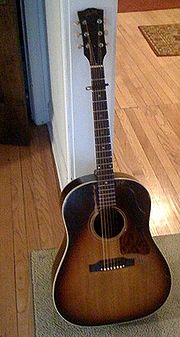
Gibson J-45
Encyclopedia

Gibson Guitar Corporation
The Gibson Guitar Corporation, formerly of Kalamazoo, Michigan and currently of Nashville, Tennessee, manufactures guitars and other instruments which sell under a variety of brand names...
. It is part of Gibson's round-shoulder, dreadnought acoustic "jumbo" line, begun in 1934 with the Gibson Jumbo Flattop which was to compete with C.F. Martin & Company's "D" line.
The J-45 is generally regarded as Gibson's most famous and widely used acoustic guitar model. Introduced in 1942 with a list price of $45, it was conceived as a replacement for the earlier J-35 model, which was an inexpensive, Great Depression
Great Depression
The Great Depression was a severe worldwide economic depression in the decade preceding World War II. The timing of the Great Depression varied across nations, but in most countries it started in about 1929 and lasted until the late 1930s or early 1940s...
-era flattop guitar. The J-45 initially only varied slightly from the discontinued J-35. Some of the changes were internal, such as strengthened bracing, while exterior changes included the new teardrop shaped pickguard, and a headstock decal with the Gibson logo replacing the old stark white 'Gibson' silk-screen logo of the thirties, and the slogan "Only a Gibson Is Good Enough." The J-45 also had a more rounded, "baseball bat" style neck, as opposed to the "V" shape of the J-35 neck. Introduced during World War II
World War II
World War II, or the Second World War , was a global conflict lasting from 1939 to 1945, involving most of the world's nations—including all of the great powers—eventually forming two opposing military alliances: the Allies and the Axis...
, the J-45 standardized Gibson's approach to the dreadnought guitar. The J-45 produced by Gibson today is substantially similar to the 1942 model.
Cosmetically, the J-45 was understated, intended as a durable no-frills "workhorse guitar" (its nickname given by the manufacturer). The binding was simple, the soundhole ring was austere, and the neck sported modest dot-shaped mother of pearl fretboard position markers. Gibson typically used the sunburst finish to cover up imperfections in the wood used on instruments, since it made the majority of the top of the guitar black. The J-45 was constructed of solid (as opposed to laminated) spruce
Spruce
A spruce is a tree of the genus Picea , a genus of about 35 species of coniferous evergreen trees in the Family Pinaceae, found in the northern temperate and boreal regions of the earth. Spruces are large trees, from tall when mature, and can be distinguished by their whorled branches and conical...
wood for the top, while solid mahogany
Mahogany
The name mahogany is used when referring to numerous varieties of dark-colored hardwood. It is a native American word originally used for the wood of the species Swietenia mahagoni, known as West Indian or Cuban mahogany....
was used for the back and sides. In the intervening years though, the Gibson sunburst has become iconic to the degree that collectors prefer the J-45 to the higher end J-50s of the same era. Apart from a small batch of natural-finish J-45s produced in 1942, the model was offered only in the sunburst finish. The J-45 is known for its warm bass sound and good projection, as well as outstanding playability.
In 1947 Gibson officially introduced the J-50 guitar, essentially a natural-finish J-45, though in 1942 already Gibson shipped a handful of J-50 guitars. One difference between the two is the top, which is triple-bound in the J-50 instead of single-bound; however, Gibson also made some early J-45s with a triple-bound top. As mentioned, the sunburst finish was useful in hiding flaws in the wood. The J-50 wasn't introduced until after World War II
World War II
World War II, or the Second World War , was a global conflict lasting from 1939 to 1945, involving most of the world's nations—including all of the great powers—eventually forming two opposing military alliances: the Allies and the Axis...
. Decent wood supplies were easier to come by, so Gibson didn't need to resort to using imperfect wood on all its instruments. This better quality wood justified the production of the natural-finish J-50, as there were very few flaws which needed to be covered up by a sunburst finish. Gibson did continue to produce the sunburst J-45, however, and it is still an important part of Gibson's production line today.
External links
- J-45 information site
- Gibson J-45
- Gibson J-45 on Fretbase - includes specs, photos and videos

